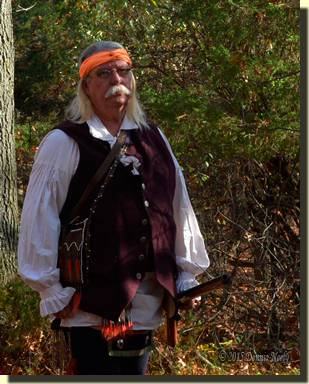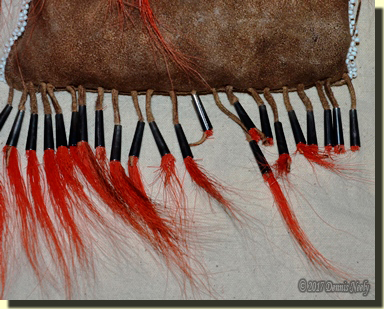Deer ears twitched. A second pair, not as alert, plodded behind, then paused. The larger doe watched, then nibbled on a tender twig. She commenced walking north on the mid-hill trail with what little wind there was at her rump. The air was warm and humid, more like early October; unseasonable for late-November. There was no overwhelming woodland aroma to speak of, other than the hint of impending rain and perhaps a twinge of moldy cedar duff, cleared away with a buffalo-hide moccasins an hour before.

The pair continued on, neither of interest to Msko-waagosh. A fox squirrel chattered away in the forked red oak, the crooked one that grew at the edge of the huckleberry swamp. To the west, a blue jay screamed. Three other jays flew in that direction, navigating through the fog that hung over the tangle. Two swooped low over the brush and gray, branchless tree trunks; the third stayed high.
The River Raisin skimmed over with ice early, but now flowed free. Canada geese ke-honked overhead now and again, some winging to the river, some leaving and flying east. Then a single muzzle blast erupted on the Raisin’s far side. The musket’s thunder echoed over the dried sedge grass, Indian reeds and cattails, silencing the geese. The returned white captive’s thumb gripped the firelock’s cock, realizing he was not alone in his wilderness haven on that Friday in 1794.
A pair of Sandhill cranes passed above with quiet swooshes. They uttered not a sound. Over a twenty-minute span, the forest grayed. The haze thickened. The air chilled. The two does were long gone. A string of fourteen cranes came from the south, chortling as they flew. About then the mist began. Ten minutes later, an easy rain pattered on the damped leaves.
The trade gun’s lock slid back under Msko-waagosh’s right arm. The stock rested against his shot pouch and horn. Once again he picked up the split pouch that rested in the duff beside his right thigh. He removed the folded page, pulled out the brass lead-holder and added his thoughts to the short sentences written just after first light…
Everyday Wear and Tear
Authenticity is a key element of any traditional black powder hunt. The degree of devotion to a real-to-life portrayal rests with the individual. Some traditional hunters establish a basic level of period-correct—“this is okay”—while others go through a constant cycle of research and evaluation. For the latter living historians, the goal is constant improvement of one’s time-traveling adventures.
Another key element is a reliance on in-the-field experience. For these folks, the forest becomes a living, breathing and ever-changing wilderness classroom, a laboratory for experimentation, testing and learning. If a given accoutrement does not perform in the midst of a simple pursuit, then questions arise.

For example, Msko-waagosh’s shot pouch is adorned with deer-hair cones, just as the original pouch was. When new, the pouch looked new. It did not have the trail-worn patina of the original, especially the deer-hair cones. The original cones sported broken stubble, not long flowing red hairs. Further, if carried on the right side, the leading cones had shorter stubble than the back cones.
Several years of hard hunting by the returned captive has left the front cones of his pouch in the same condition displayed by the original artifact. Everyday wear and tear modified the new creation so that its condition mirrored that of the 18th-century survivor. For me, this is the essence of wilderness classroom learning—hands-on experience mirrors journal passages or surviving artifacts of long ago.
Over the years, a recurring topic of discussion among re-enactors is the validity of surviving museum artifacts. One group follows the philosophy that if it survived as a “collected trophy,” such as in Sir John Caldwell’s material goods, then it must be authentic. The second group seems a tad bit skeptical, often citing the “It looks too new” impression as a point of concern.
I know this sounds silly, but one criterion that I try to apply to any item when seeking potential artifacts for one of my personas is a careful examination for honest wear and tear. I want an accoutrement that was used in the field, not a pristine example that should have the price tag still attached—with apologies to Minnie Pearl.
Likewise, I’m not a fan of artificial aging, other than now and then adding some wear and tear to get past the “It looks too new” stage. I don’t want to use a shot pouch that is falling apart and needs to be handled with white cotton gloves, because it looks two-centuries old.
One of the many goals of this pastime is to learn how to survive on a daily basis using the clothing and accoutrements that our forefathers relied upon. A number of times I have discovered that “common knowledge” explanations that go along with specific artifacts don’t work in a backcountry circumstance. The premise of the hypothesis makes sense and thus is accepted as fact, but in reality, the theory does not hold up under wilderness laboratory tests. Yet, these failures lead to discoveries of what does work, or how a hunter hero “might have used” the item with success.
Once again, I was rummaging through Jonathan Alder’s journal in search of an unrelated passage when I came across this gem:
“Barshaw, the sister of Big Turtle (she was somewhat older than I), was a squaw of great ingenuity and handy with her needle on all kinds of fine work. She made and sold a great many moccasins that was very ingeniously covered with beads and porcupine quills of different colors. She would make pictures of birds, squirrels, deer, or bear and then very readily sell them to the French and British at a high price…” (Alder, 103)
I’ve read over that passage a dozen times. I have it marked for the reference to moccasins with beads and porcupine quills, but I never tumbled to what Alder was saying: Barshaw was making genuine Native American artifacts for the tourist trade, i.e. the French and British military garrisons. It’s amazing how one sentence can change one’s living history perspective!
The upshot of this statement from 1792 is that I now have to take a look at some of these items in collections attributed to British military folks stationed in the Great Lakes region—Caldwell, Foster and others. There are some that “look too new,” with no sign of wear from usage. That changes the complexion of those surviving artifacts, and unfortunately there is no going back and asking about the circumstances of their collection.
In addition, Alder’s revelation supports the practice of relying on existing museum examples that show noticeable use. The proof is in re-creating an accoutrement and then heading to the field to use it in a real life circumstance. Over time, the wear and tear should mirror that of the original. If “It looks too new,” then there might be cause for concern…
Give traditional black powder hunting a try, be safe and may God bless you.



One Response to “It looks too new…”